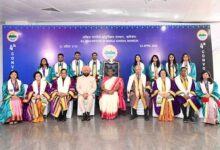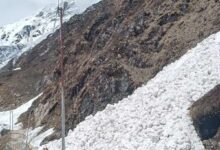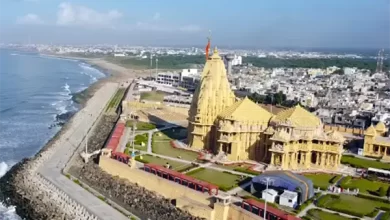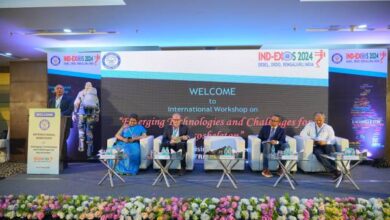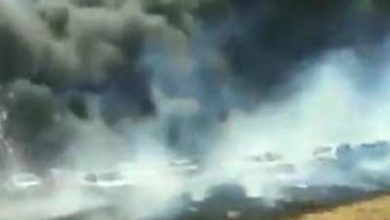CM at NITI Aayog-“We are a young state on the rise”
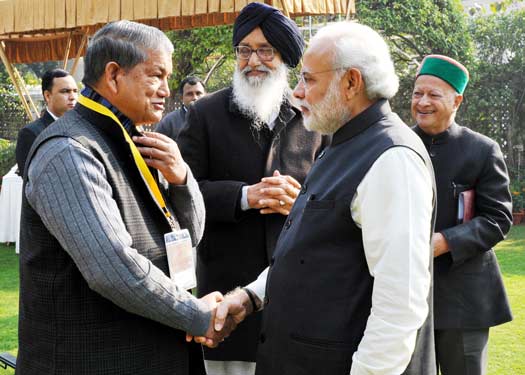
New Delhi
“We are a young state on the rise. We lack resources and, as such, it is imperative that our special state status be maintained. All our plans should be funded on the 90:10 ratio basis.”
This was stated by Chief Minister Harish Rawat at the first meeting of the NITI Aayog held in New Delhi, today, under the chairmanship of Prime Minister Narendra Modi.
Before the meeting, the Chief Minister informed the PM that a Cabinet Minister of the state had died and he had to be in Haridwar for the last rites. The PM agreed to his speech being brought forward. Being the second speaker at the meeting, CM Rawat presented his views in a positive atmosphere before the PM, following which he left for Haridwar.
CM hopes to get a Green Bonus for Uttarakhand
He suggested that no change be made in the present dispensation for the period of the 12 Five Year Plan. He sought constitution of a Central Himalayan Council similar to the North-Easter Council. Also, the acceptance of recommendations made for the Himalayan States by the Committee constituted under Planning Commission Member BK Chaturvedi in 2013. He demanded a Green Bonus for Uttarakhand. According to a study undertaken by the Union Government, the annual worth of the environmental service provided by Uttarakhand amounted to Rs 16 lakh crores. While estimating the GDP, Green Accounting needed to be considered, so that forests were not considered a liability. The CM also demanded cancellation of the Bhagirathi Eco System Zone Notification 2012 under which 4200 sq kilometres Land of Uttarkashi had been declared eco-sensitive in a small district. He reminded that in this context the Bhagirathi River Valley Development Authority was already in existence.
Chief Minister Rawat emphasised that the state’s boundaries were along international borders and, as such, it would be appropriate that roads, railway lines, airstrips, telecommunications and other infrastructure development be done by the Union Government with its resources. As part of this, to ensure development of border areas and national security, a Trans-Himalayan Highway needed to be constructed. Construction of the Tanakpur-Jauljivi Road on the India-Nepal border needed to be speeded up. Jolly Grant Airport required to be upgraded to international status, and Pantnagar as a cargo airport. Other airstrips like Naini-Saini, Chinyalisaud, Gauchar, etc., needed to be improved and expanded.
Pointing out that Hydro-Power was clean energy, Chief Minister Rawat expressed regret that many projects had been stalled in the name of environmental conservation, or awaited clearance. He sought speedy decisions on the state’s projects. There was also need to develop Uttarakhand as a water hub because the nation’s major rivers emanated from it. Taking the initiative in this direction, the state government had made a plan to plant trees and develop water bodies in the watershed areas. Help was required for this. He also appealed for the exclusion of excavation from riverbeds from classification as mining, because the debris that collected in rivers from mountain erosion, landslides and floods, caused damage to river banks and settlements. As such, the rivers needed to be cleared regularly.
Uttarakhand needs to be developed as a Water Conservation Hub
Congratulating the PM on the ‘Namami Gange’ Project, the CM affirmed that it would prove a milestone in reviving the holy river. He advised that to make the project a success, the Ganga’s source, Uttarakhand, needed to be developed as a Water Conservation Hub. The state government had already taken the initiative on this by planting trees and establishing water bodies. Seventy percent of the state’s area constituted forests. The entire nation benefited from its environmental benefits, but the cost of conservation and preservation was being borne by the state, therefore a Green Bonus ought to be paid. Including Environmental Damage and Conservation in the GDP would lead to sustainable development. The sacrifices of states in this regard and the disabilities suffered ought to be factored into the Union Budget in light of the Chaturvedi Committee recommendations.
Disaster prone villages needed to be rehabilitated. The number of such villages had risen to 337 after the June, 2013 disaster. People needed to be taken to safe areas, which required swapping of forest lands. The National Disaster Management Authority could help by preparing a project in this regard. The Union Forest and Environment Ministry had banned construction in an area comprising 4180 sq kilometres in the Bhagirathi Watershed without consulting the State Government. Local villagers would have to take permission from the Ministry even to construct a single room. People were being compelled to migrate from the area. Such bans in the hill areas, particularly on the border, were forcing people to migrate to urban areas for the sake of basic amenities. This was not only increasing pressure on the towns, but also increasing the number of slums. As such, there was need to focus on developing urban infrastructure. It would help if a Dehradun-Haridwar-Rishikesh Metro Service was developed. It was suggested that, considering the small size of existing towns, an integrated Smart City Project be prepared for the Rudrapur-Kiccha- Pantnagar-Haldwani-Kathgodam belt, connected by Metro Services.
Owing to the existence of pilgrimage and holy sites in the state, the burden of an additional population of 3-4 crore had to be borne, for which the necessary infrastructure was required. As many as 8 crore people visited the 2010 Mahakumbh. This shifting population needed to be counted whilst planning urban infrastructure development under JNNURM, Drinking Water, Sanitation and Health facilities. The norms for carrying capacity of Smart Cities needed to be relaxed while selecting them.
The CM reminded that the Ardh Kumbh would be held next year in the state, which would be attended by pilgrims from India and abroad. The Haridwar Kumbh Area had to be prepared from right now with necessary amenities. The assistance of the Union Government was required in this regard.
Large industries associated with Digital India could be established in Haridwar and Udham Singh Nagar, in accordance with the Make In India concept.
In light of the geographical conditions of the state, Satellite Connectivity had to be provided along with the National Optical Fibre Network (NOFN). The State Government was committed to providing free right of way for laying of Optical Fibre Cable under the NOFN. Considering the Ardh Kumbh in Haridwar, priority needed to be given to laying Optical Fibre Cable in Haridwar and Dehradun.
Chief Minster Rawat appealed to the PM that states be consulted whilst formulating policies so that the federal structure was enhanced and the national economy developed in an integrated and inclusive fashion. In the context of changing circumstances at the national level, Uttarakhand had set up a Policy Planning Group for better coordination.
Present at today’s meeting were Union Finance Minister Arun Jaitley, Home Minister Rajnath Singh, and Chief Ministers of various states.

